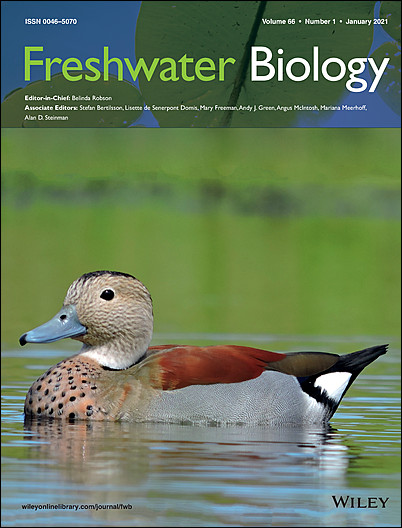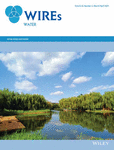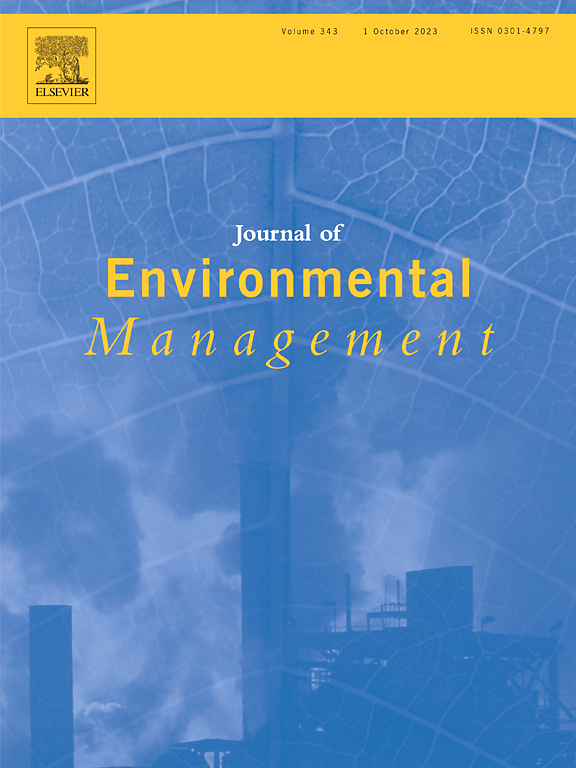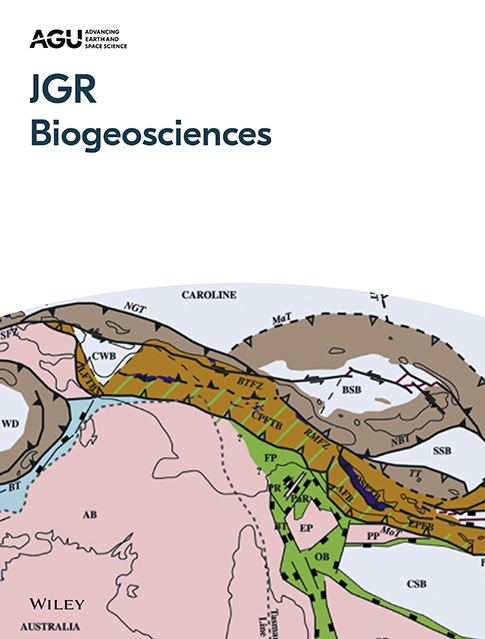Please find all scientific publications of IGB under > scientific publications
For more detailed information please refer to our > library catalogue
31 - 40 of 133 items
- Department:(Dept. 2) Community and Ecosystem Ecology
January 2025
Freshwater Biology. - 70(2025)1, Art. e14383
Contrasting Effects of Increasing Invasive Crayfish Densities on Competing Submerged Macrophytes in Shallow Lakes
Lei Li; Sabine Hilt; Mingming Ding

January 2025
Ecology and Evolution. - 15(2024)1, Art. e70787
Divorce Rates Better Predict Population-Level Reproductive Success in Little Penguins Than Foraging Behaviour or Environmental Factors
Matthew D. Simpson; Ashton L. Dickerson; Andre Chiaradia; Lloyd Davis; Richard D. Reina
January 2025
WIREs Water. - 12(2025)1, Art. e70001
A Holistic Catchment-Scale Framework to Guide Flood and Drought Mitigation Towards Improved Biodiversity Conservation and Human Wellbeing
Phillip J. Haubrock; Rachel Stubbington; Nicola Fohrer; Henner Hollert; Sonja C. Jähnig; Bruno Merz; Claudia Pahl-Wostl; Holger Schüttrumpf; Doerthe Tetzlaff; Karsten Wesche; Klement Tockner; Peter Haase
The authors suggest to combine conventional civil engineering methods, nature-based solutions, and biodiversity conservation actions at catchment-scale to leverage flood and drought mitigation and cater to improved biodiversity conservation and human wellbeing. We outline the needs in terms of legislation structure, adequate funding and governance structures to make this happen.
January 2025
Science of The Total Environment. - 959(2025), Art. 178180
Evaluating the readiness for river barrier removal: A scoping review under the EU nature restoration law
Mayra E. Darre; Petros Constantinides; Sami Domisch; Mathieu Floury; Virgilio Hermoso; Michael Ørsted; Simone D. Langhans

January 2025
Environmental Management. - XX(2024)XX, XX-XX
Identifying Major Factors for Success and Failure of Conservation Programs in Europe
Nina Farwig; Philipp P. Sprenger; Bruno Baur; Katrin Böhning-Gaese; Angelika Brandt; Nico Eisenhauer; Götz Ellwanger; Axel Hochkirch; Alexandros A. Karamanlidis; Marion Mehring; Martin Pusch; Finn Rehling; Nike Sommerwerk; Theresa Spatz; Jens-Christian Svenning; Sabine Tischew; Klement Tockner; Teja Tscharntke; Alice B. M. Vadrot; Julian Taffner; Christine Fürst; Sonja C. Jähnig; Volker Mosbrugger

January 2025
Ecosystem Services. - 70(2024)13, Art. 101673
A global systematic review of the cultural ecosystem services provided by wetlands
Kevin A. Wood; Lucy L. Jupe; Francisca C. Aguiar; Alexandra M. Collins; Scott J. Davidson; Will Freeman; Liam Kirkpatrick; Tatiana Lobato-de Magalhães; Emma McKinley; Ana Nuno; Jordi F. Pagès; Antonella Petruzzella; Dave Pritchard; Jonathan P. Reeves; Sidinei Magela Thomaz; Sara A. Thornton; Hiromi Yamashita; Julia L. Newth
January 2025
Scientific Data. - 11(2024)1, Art. 601
Time series of freshwater macroinvertebrate abundances and site characteristics of European streams and rivers
Ellen A. R. Welti; Diana E. Bowler; James S. Sinclair; Florian Altermatt; Mario Álvarez-Cabria; Giuseppe Amatulli; David G. Angeler; Gaït Archambaud; Iñaki Arrate Jorrín; Thomas Aspin; Iker Azpiroz; Nathan Jay Baker; Iñaki Bañares; José Barquín Ortiz; Christian L. Bodin; Luca Bonacina; Núria Bonada; Roberta Bottarin; Miguel Cañedo-Argüelles; Zoltán Csabai; Thibault Datry; Elvira de Eyto; Alain Dohet; Sami Domisch; Gerald Dörflinger; Emma Drohan; Knut A. Eikland; Judy England; Tor E. Eriksen; Vesela Evtimova; Maria J. Feio; Martial Ferréol; Mathieu Floury; Maxence Forcellini; Marie Anne Eurie Forio; Riccardo Fornaroli; Nikolai Friberg; Jean-François Fruget; Jaime R. Garcia Marquez; Galia Georgieva; Peter Goethals; Manuel A. S. Graça; Andy House; Kaisa-Leena Huttunen; Thomas Correll Jensen; Richard K. Johnson; J. Iwan Jones; Jens Kiesel; Aitor Larrañaga; Patrick Leitner; Lionel L’Hoste; Marie-Hélène Lizée; Armin W. Lorenz; Anthony Maire; Jesús Alberto Manzanos Arnaiz; Brendan Mckie; Andrés Millán; Timo Muotka; John F. Murphy; Davis Ozolins; Riku Paavola; Petr Paril; Francisco Jesús Peñas Silva; Marek Polasek; Jes Rasmussen; Manu Rubio; David Sánchez Fernández; Leonard Sandin; Ralf B. Schäfer; Astrid Schmidt-Kloiber; Alberto Scotti; Longzhu Q. Shen; Agnija Skuja; Stefan Stoll; Michal Straka; Rachel Stubbington; Henn Timm; Violeta G. Tyufekchieva; Iakovos Tziortzis; Yordan Uzunov; Gea H. van der Lee; Rudy Vannevel; Emilia Varadinova; Gábor Várbíró; Gaute Velle; Piet F. M. Verdonschot; Ralf C. M. Verdonschot; Yanka Vidinova; Peter Wiberg-Larsen; Peter Haase
January 2025
Freshwater Biology. - 70(2025)1, Art. e14363
Submerged Macrophytes Can Maintain Stable Dominance Over Free-Floating Competitors Through High pH
Sándor Szabó; Noémi Fedor; Gergő Koleszár; Mihály Braun; János Korponai; Aleksandra Kočić; Sabine Hilt; Viktor Oláh
December 2024
Environmental Management. - XX(2024)XX, XX-XX
Does Perceived Nuisance Abundance of Water Plants Match with Willingness-to-Pay for Removal? Contrasts Among Different User Categories
Jan E. Vermaat; Kirstine Thiemer; Bart Immerzeel; Susanne C. Schneider; Keneilwe Sebola; Julie Coetzee; Antonella Petruzzella; Samuel N. Motitsoe; Mathieu Baldo; Benjamin Misteli; Gabrielle Thiébaut; Sabine Hilt; Jan Köhler; Sarah Faye Harpenslager
December 2024
Journal of Geophysical Research : Biogeosciences. - 129(2024)12, Art. e2024JG008140
Controls on Lake Pelagic Primary Productivity: Formalizing the Nutrient‐Color Paradigm
Isabella A. Oleksy; Christopher T. Solomon; Stuart E. Jones; Carly Olson; Brittni L. Bertolet; Rita Adrian; Sheel Bansa; Jill S. Baron; Soren Brothers; Sudeep Chandra; Hsiu‐Mei Chou; William Colom‐Montero; Joshua Culpepper; Elvira de Eyto; Matthew J. Farragher; Sabine Hilt; Kristen T. Holeck; Garabet Kazanjian; Marcus Klaus; Jennifer Klug; Jan Köhler; Alo Laas; Erik Lundin; Alice H. Parkes; Kevin C. Rose; Lars G. Rustam; James Rusak; Facundo Scordo; Michael J. Vanni; Piet Verburg; Gesa A. Weyhenmeyer






